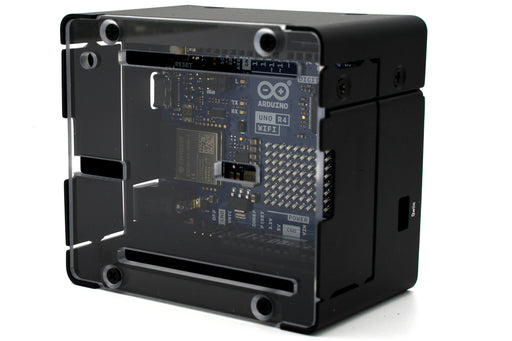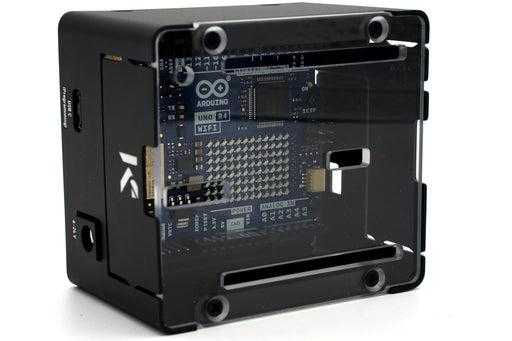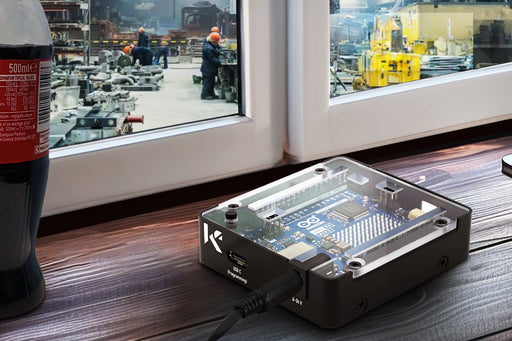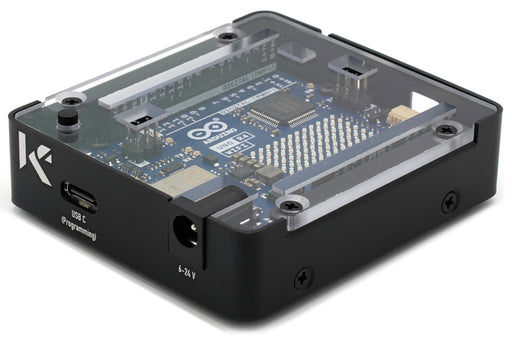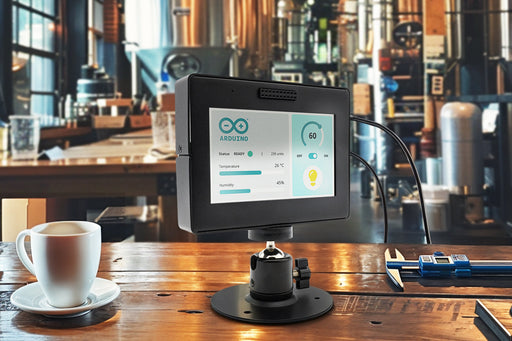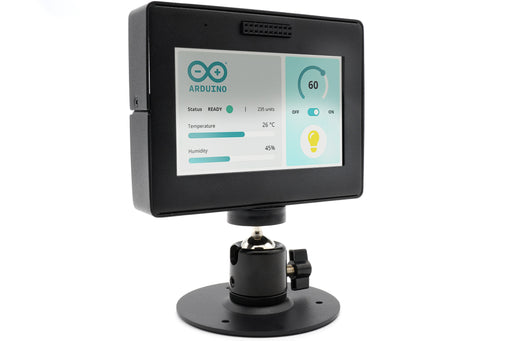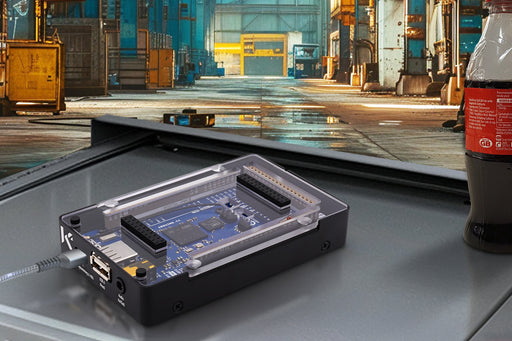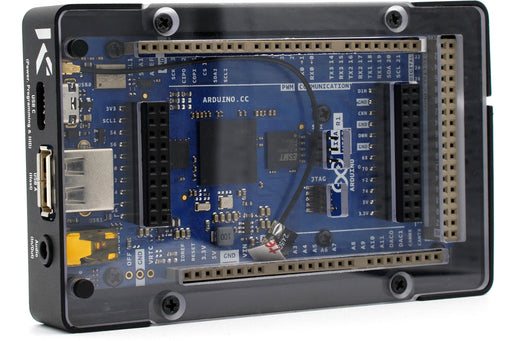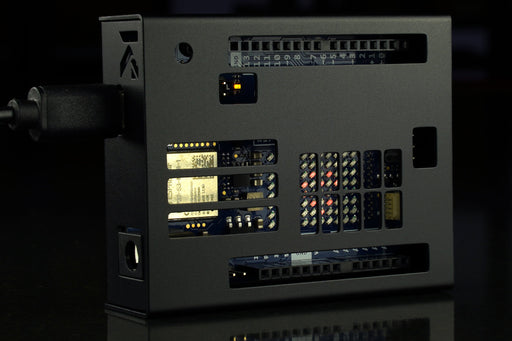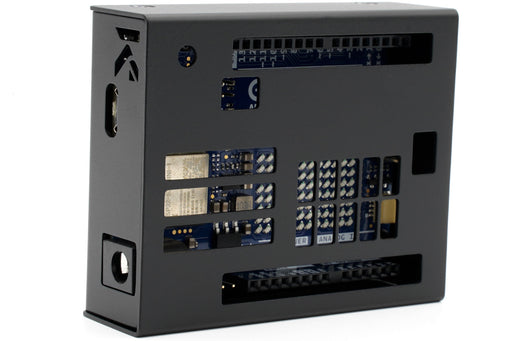Arduino UNO R4 Minima
Downloads
The Arduino UNO R4 Minima takes microcontroller technology to unprecedented heights, elevating your projects to new dimensions of performance and versatility. With a formidable 32-bit microcontroller by Renesas at its core, this revolutionary board offers a host of enhanced features that redefine what's possible in the world of electronics. From beginners embarking on their electronic journey to seasoned enthusiasts pushing the boundaries of innovation, the UNO R4 Minima caters to all with its unwavering reliability and cutting-edge capabilities.
Seamless Evolution within the Arduino Ecosystem

Maintaining fidelity to the celebrated UNO form factor, the UNO R4 Minima remains in harmony with its predecessor, the UNO R3. Retaining the well-loved pinout, 5 V operating voltage, and form factor ensures a seamless transition for existing shields and projects. This compatibility underscores the UNO R4 Minima's commitment to leveraging the extensive Arduino UNO ecosystem, enabling you to harness a wealth of resources that have already been established for the platform.
Unparalleled Power and Performance
Experience a paradigm shift in processing power and project complexity management. With expanded memory and a turbocharged clock speed, the UNO R4 Minima enables precision-calibrated calculations and effortless handling of intricate projects. Its enhanced capabilities empower you to undertake ambitious tasks with confidence and finesse.
Unleash Creativity with On-Board Peripherals
Dive into a world of endless possibilities, thanks to the array of additional on-board peripherals embedded within the UNO R4 Minima. Unlock the potential of a 12-bit DAC, CAN BUS, and OP AMP, expanding your design horizons and granting you unparalleled flexibility. These integrated components serve as your creative toolkit, facilitating innovative solutions and inspiring your boldest ideas.
Versatility Redefined with Extended Voltage Tolerance
Amplify your projects by embracing a broader voltage range. The UNO R4 Minima now supports inputs of up to 24 V, streamlining your endeavors by consolidating power sources. Seamlessly integrate motors, LED strips, and various actuators, reducing complexity and elevating efficiency.
Precision Debugging, Enhanced Control
Debugging is no longer an obstacle; it's a strategic advantage. By incorporating an SWD connector, the UNO R4 Minima affords you unmatched visibility into your system's inner workings. Seamlessly connect an external debugger and monitor your project's heartbeat in real time, ensuring meticulous control and invaluable insights.
Empower Interaction with Built-In HID Support
The UNO R4 Minima heralds a new era of interaction with its built-in HID (Human Interface Device) support. Seamlessly emulate a mouse or keyboard when connected to a computer via USB cable. Effortlessly send keystrokes and mouse movements, enhancing usability and functionality while redefining user experiences.
Unveil Unlimited Potential
The Arduino UNO R4 Minima is your passport to uncharted territories of innovation. Its extraordinary features and heightened capabilities render it an indispensable companion for your most audacious ventures. From its unwavering compatibility to its augmented performance and expanded peripherals, the UNO R4 Minima is your gateway to a world of possibilities. Elevate your projects, amplify your creativity, and revolutionize your journey with the unparalleled prowess of the Arduino UNO R4 Minima.
Some Examples of Possible Applications

- Home Automation: Create smart home systems that control lighting, temperature, and appliances with enhanced processing power and expanded memory.
- Robotics: Develop sophisticated robots with precise control and intricate movements, leveraging the extended peripherals and improved performance of the board.
- Industrial Automation: Design industrial control systems for factories and production lines, utilizing the increased processing capabilities and extended voltage tolerance.
- Data Acquisition: Build advanced data logging and acquisition systems that handle a large amount of sensor data, thanks to the improved memory and processing speed.
- IoT Devices: Develop Internet of Things devices that gather, process, and transmit data seamlessly, taking advantage of the increased connectivity options and enhanced processing.
- Gaming Gadgets: Create custom gaming peripherals, interactive controllers, and immersive experiences by utilizing the HID support and onboard peripherals.
- Automotive Electronics: Design automotive diagnostic tools, dashboard displays, and vehicle monitoring systems with the board's enhanced capabilities and connectivity.
- Audio Processing: Build high-quality audio processing systems, synthesizers, and effects units using the improved memory and processing power.
- Medical Devices: Develop medical monitoring devices, wearable health trackers, and portable medical equipment that require precise calculations and reliable performance.
- Environmental Monitoring: Design environmental monitoring stations that track parameters such as air quality, temperature, and humidity, utilizing the extended memory and connectivity options.
- Educational Tools: Create advanced educational kits that introduce students to complex electronics concepts, benefiting from the compatibility with existing Arduino shields and accessories.
- Art Installations: Develop interactive art installations that respond to user input and sensor data, using the board's expanded capabilities for creative expression.
- Agricultural Automation: Build systems for precision agriculture, such as automated irrigation and monitoring systems, by leveraging the extended voltage tolerance and processing power.
- Security Systems: Design advanced security and surveillance systems that process and analyze data efficiently, integrating with various sensors and cameras.
- Wearable Technology: Create innovative wearable devices with improved functionality, offering features like gesture recognition and biometric tracking.
- Communication Devices: Develop custom communication devices, such as wireless sensor nodes and remote control systems, utilizing the onboard peripherals and connectivity options.
- Scientific Instrumentation: Design scientific instruments and laboratory equipment that require precise measurements and data analysis, taking advantage of the improved processing capabilities.
- Prototyping and Rapid Development: Use the board as a rapid prototyping platform for testing ideas and concepts across various domains due to its compatibility and enhanced features.
Specifications
- Microcontroller: RA4M1 Renesas ARM Cortext-M4
- Programming Port: USB-C
- Digital I/O Pins: 14
- Analog Input Pins: 6 PWM Pins: 6
- DAC: 1
- Communication Pins: UART x1, SPI x1, I2C x1, CAN Bus x1
- Input Voltage (VIN): 6V ~ 24V
- Circuit Operating Voltage: 5V
- DC Current: 8mA per I/O Pin
- Clock Speed: 48MHz (Main Core)
- Memory: 256 kB Flash and 32 kB RAM (RA4M1)
- Dimensions: 68.85mm x 53.34mm

Items Included
- Arduino UNO R4 Minima






